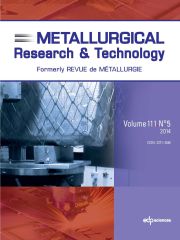Article contents
Thermodynamics of vitreous transition
Published online by Cambridge University Press: 13 March 2012
Abstract
The maximum value at equilibrium of the relaxed enthalpy of some glasses is viewed as alinear function of the annealing temperature from the Kauzmann temperatureTK up to a vitreous transition temperature T*g which is not time dependent. The frozen enthalpy and entropy at T*gare determined from the specific heat difference between glass andundercooled melt which is constant between TKandT*g. The Gibbs free energy change at T*g is equal to zero. The vitreous transition is a thermodynamic transitionwithout latent heat. A model is used to describe this phenomenon. A volume energy saving εv equivalent to a complementary Laplace pressure has beenadded to the classical Gibbs free energy change for a crystal formation in a melt. Thereis a change of the Vogel–Fulcher–Tammann (VFT) temperature at T*g corresponding to a decrease of the free volume disappearancetemperature. Scaling laws linking the crystal homogeneous nucleation temperatures to T*g are used to predict the two VFT temperatures, the thermodynamic vitreoustransition induced by vitreous (super)-clusters and the frozen enthalpy and entropy at T*g only knowing T*g, the melting temperature Tmand the fusion heat ΔHm of any fragileglass-forming melt.
- Type
- Research Article
- Information
- Copyright
- © EDP Sciences 2012
References
- 4
- Cited by


